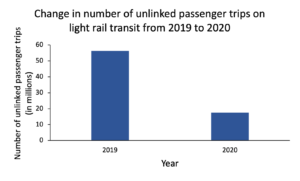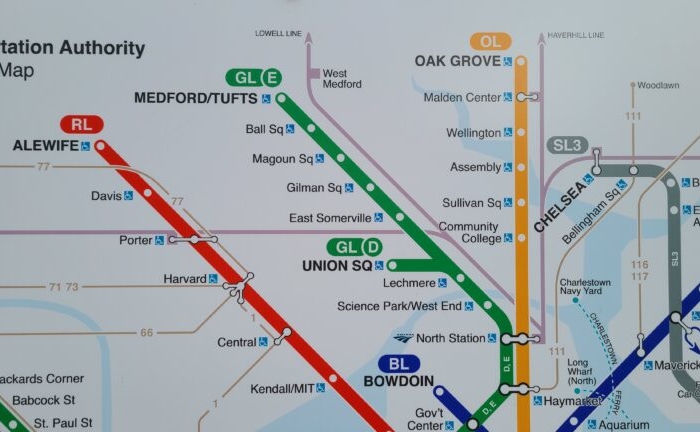The Effects of the COVID 19 Pandemic on MBTA Light Rail Ridership
In 2020, the COVID 19 pandemic had an unprecedented impact on public transportation. According to Pioneer Institute’s site, MBTA Analysis, nationwide ridership on light rail transit decreased by historic amounts between 2019 and 2020. For example, the New Jersey Transit Corporation reported a 93% decrease in unlinked light rail passenger trips in April 2019 and April 2020. The Maryland Transit Administration saw a 92% decrease in light rail ridership in that time period. Additionally, the Massachusetts Bay Transportation Authority (MBTA) reported a 95% decrease in light rail ridership.
The MBTA light rail transit includes the Green Line and a small part of the Red Line (from Ashmont to Mattapan). Throughout the pandemic, many service cuts occurred, resulting in less frequent light rail service. Although the non-monthly pass fare revenue rates are starting to recover as of the spring of 2021, the rates are still far below 2019 levels.
That year, the MBTA reported 56,383,908 unlinked light rail passenger trips. In 2020, the year most impacted by the COVID 19 pandemic, this number dropped down to 17,490,268 (Figure 1).

Figure 1. The change in the number of unlinked passenger trips from 2019 (pre-pandemic) to 2020 (pandemic).
This decline in light rail transit ridership in Massachusetts represents a decrease of 69% from 2019 to 2020. However, ridership data from 2021 suggest that unlinked passenger trips may be slowly returning to pre-pandemic levels.
In 2020, unlinked passenger trips on light rail transit plummeted with the onset of the pandemic. In February 2020, 16,231,994 unlinked light rail passenger trips were recorded. In March 2020, ridership dropped to 10,880,362 unlinked passenger trips. By April 2020, ridership hit an all-time low of 4,223,422 unlinked trips. This number decreased by 74% from February 2020 to April 2020, in the beginning of the pandemic.
However, ridership on light rail transit has been gradually increasing in 2021. For example, in January 2021, 902,750 unlinked light rail trips were recorded. In February, this number increased by 0.57% to 907,881 unlinked passenger trips. In March 2021, 1,127,876 unlinked light rail passenger trips were recorded. From February to March, unlinked passenger trips increased by 24.23% on light rail transit. In April, unlinked passenger trips on the light rail increased by nearly 4% to 1,171,921 trips (Figure 2).

Figure 2. The change in the number of unlinked passenger trips on MBTA light rail transit from February 2020 (near the start of the pandemic) to April 2021 (more recently).
Although this is all the current data published for ridership of light rail transit in 2021, these data may suggest that ridership may be slowly increasing toward pre-pandemic levels. However, transit ridership is typically higher in the warmer months, so this may also contribute to this observed increase in ridership.
As restrictions are lifted in Massachusetts, light rail transit plans to adopt a new summer schedule for 2021. As part of this summer schedule, the Green Line will have more trolleys active on the C, D and E branches. Additionally, the Red Line will run at a similar rate as before the pandemic. It will be interesting to see if ridership trends continue to increase toward pre-pandemic levels, as light rail transit continues to become more accessible.
About the Author: Emily Donovan is a Roger Perry Government Transparency Intern at Pioneer Institute for the summer of 2021. She is a rising senior studying Animal Behavior at Bucknell University.



